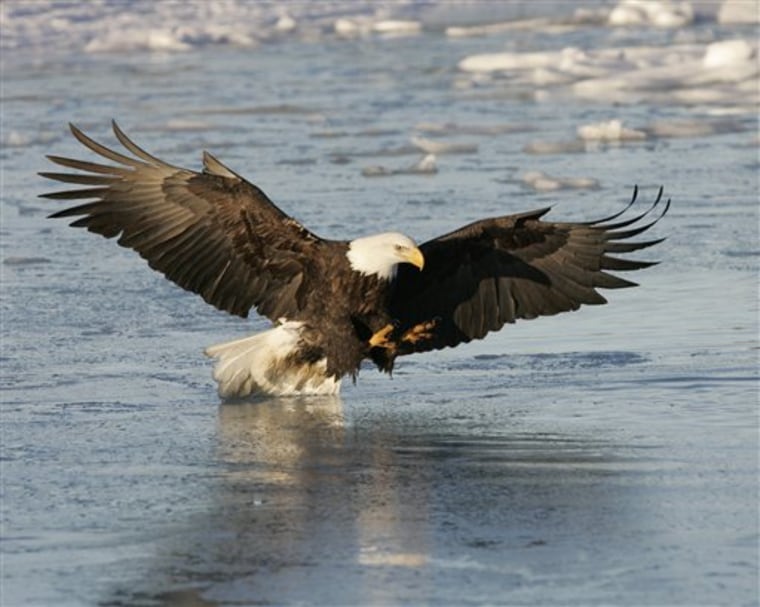The proud symbol of a nation for more than two centuries, the iconic and elegant American bald eagle also is emblematic of a snail-paced federal bureaucracy.
Seven years after the government said the fierce raptor is no longer threatened with extinction, officials this week announced a plan for removing it from the endangered species list.
“Partly it just fell through the cracks,” said Jamie Rappaport Clark, executive vice president of Defenders of Wildlife, who proposed delisting the bird in 1999 while she was President Clinton’s Fish and Wildlife Service director.
The process has taken far longer than the typical year, partly because updated counts are required from each of the states, and some of those have rules that add red tape.
Clark called the bald eagle “a success story” for the embattled Endangered Species Act, which Republicans in Congress and the Bush administration have been pushing to reshape so that more responsibility is given to private landowners instead of the federal government.
“Across the range, you can’t deny the incredible success of the return of the bald eagle,” she said. “A lot of attention, energy and money was put into its recovery.”
Overcame DDT, habitat loss
The bird has battled back from the threat of extinction because of habitat loss and the pesticide DDT.
The Interior Department’s Fish and Wildlife Service issued draft voluntary guidelines spelling out how landowners, land managers and others should protect the bird once the 1973 law no longer safeguards it.
It also proposed prohibitions on “disturbing” the bald eagle, which could include anything that would disrupt its breeding, feeding or sheltering or cause injury, death or nest abandonment.
Officials said Monday’s action could lead to the bald eagle coming off the endangered species list within the next year or so.
“Should the eagle be delisted, we expect that the public will notice little change in how eagles are managed and protected,” said H. Dale Hall, the Fish and Wildlife Service’s director.
7,066 known nesting pairs
Hall said at least 7,066 known nesting pairs now exist in the contiguous United States. The bald eagle’s territory stretches over much of the North American continent. Tens of thousands more live in Alaska and Canada, where their existence never was imperiled.
However, 43 years ago, there were just 417 known nesting pairs left in the lower 48 states, mainly because of the widespread use of DDT and other pesticides that weakened the bald eagle’s eggshells and reduced its birth rate. The brown-bodied bird with the distinctive white head and tail also suffered from lead poisoning — eating waterfowl pierced by a hunter’s lead shot.
In 1967, under a law that preceded the Endangered Species Act, the bald eagle was declared an endangered species in the lower 48. In 1972, the Environmental Protection Agency banned DDT for most uses.
Fish and Wildlife officials in 1978 listed the bald eagle as endangered in 43 states and threatened in Washington, Oregon, Minnesota, Michigan and Wisconsin. The government hatched detailed recovery plans, with specific population and reproduction goals. Sometimes eggs were imported from Canada and installed at artificial eyries.
Other laws will still be there
By 1995, the species had rebounded enough to be reclassified as threatened throughout the lower 48.
If and when the bald eagle is removed from the endangered list, two other laws will continue to protect it: the 1918 Migratory Bird Treaty Act and the 1940 Bald Eagle Protection Act, later revised to include the golden eagle. But those don’t address habitat.
David Smith, the Interior Department’s deputy assistant secretary for fish and wildlife, said the agency wouldn’t hesitate to act “if at any time in the future it becomes evident that the eagle needs relisting for protections.”
Comments on the delisting proposal are being taken through May 17 via email to baldeagledeslisting@fws.gov.
Additional background is online at www.fws.gov/migratorybirds/baldeagle.htm.
